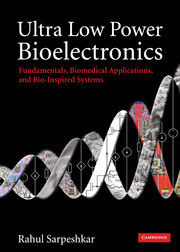Book contents
- Frontmatter
- Contents
- Acknowledgements
- Section I Foundations
- 1 The big picture
- 2 Feedback systems: fundamentals, benefits, and root-locus analysis
- 3 MOS device physics: general treatment
- 4 MOS device physics: practical treatment
- 5 MOS device physics: small-signal operation
- 6 Deep submicron effects in MOS transistors
- 7 Noise in devices
- 8 Noise in electrical and non-electrical circuits
- 9 Feedback systems
- 10 Return-ratio analysis
- Section II Low-power analog and biomedical circuits
- Section III Low-power RF and energy-harvesting circuits for biomedical systems
- Section IV Biomedical electronic systems
- Section V Principles for ultra-low-power analog and digital design
- Section VI Bio-inspired systems
- Section VII Energy sources
- Bibliography
- Index
- Epilogue
- References
2 - Feedback systems: fundamentals, benefits, and root-locus analysis
from Section I - Foundations
Published online by Cambridge University Press: 02 December 2010
- Frontmatter
- Contents
- Acknowledgements
- Section I Foundations
- 1 The big picture
- 2 Feedback systems: fundamentals, benefits, and root-locus analysis
- 3 MOS device physics: general treatment
- 4 MOS device physics: practical treatment
- 5 MOS device physics: small-signal operation
- 6 Deep submicron effects in MOS transistors
- 7 Noise in devices
- 8 Noise in electrical and non-electrical circuits
- 9 Feedback systems
- 10 Return-ratio analysis
- Section II Low-power analog and biomedical circuits
- Section III Low-power RF and energy-harvesting circuits for biomedical systems
- Section IV Biomedical electronic systems
- Section V Principles for ultra-low-power analog and digital design
- Section VI Bio-inspired systems
- Section VII Energy sources
- Bibliography
- Index
- Epilogue
- References
Summary
It is presumed that there exists a great unity in nature, in respect of the adequacy of a single cause to account for many different kinds of consequences.
Immanuel KantDevices that are hooked to each other at various terminals create a circuit. Almost all nontrivial circuits comprise topologies where output terminal(s) are directly or indirectly coupled back to input terminal(s), thus forming a feedback circuit. When the output feeds back to reduce the effects of the input, the feedback is termed negative feedback, and when the output feeds back to increase the effects of the input, the feedback is termed positive feedback. Purely feed-forward circuits are usually simple to build and easy to analyze, even when nonlinear, such that most of the complexity and richness in circuits arises from the feedback embedded within them.
Negative-feedback circuits function by creating forces within the circuit that attempt to restore its signals to a desired equilibrium point if these signals deviate away from this point. Negative-feedback circuits often serve regulatory functions improving the precision of the output to that provided by a precise equilibrium-setting reference input and/or that of a precise sensor or feedback network. Such precision is achieved in spite of imprecision in an actuator or feed-forward network in the circuit and/or disturbances present at the output of the circuit.
Positive-feedback circuits function by creating forces within the circuit that attempt to move its signals further away from a point if these signals deviate from that point.
- Type
- Chapter
- Information
- Ultra Low Power BioelectronicsFundamentals, Biomedical Applications, and Bio-Inspired Systems, pp. 28 - 56Publisher: Cambridge University PressPrint publication year: 2010
References
- 1
- Cited by



